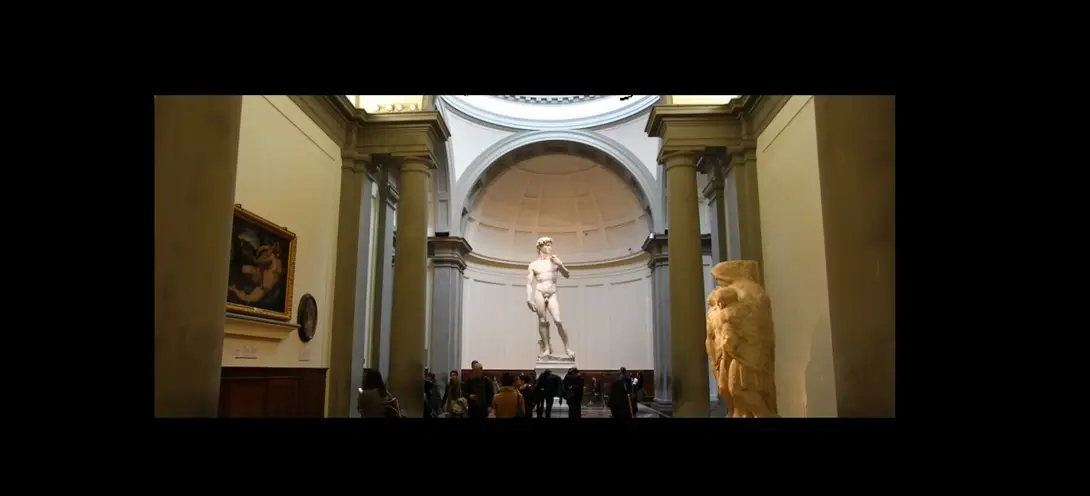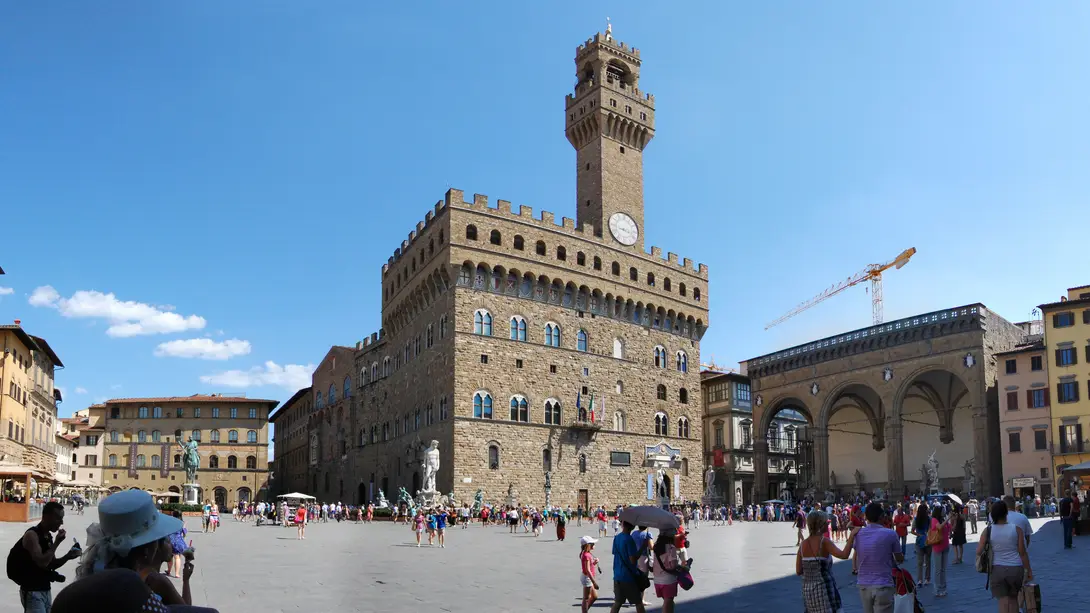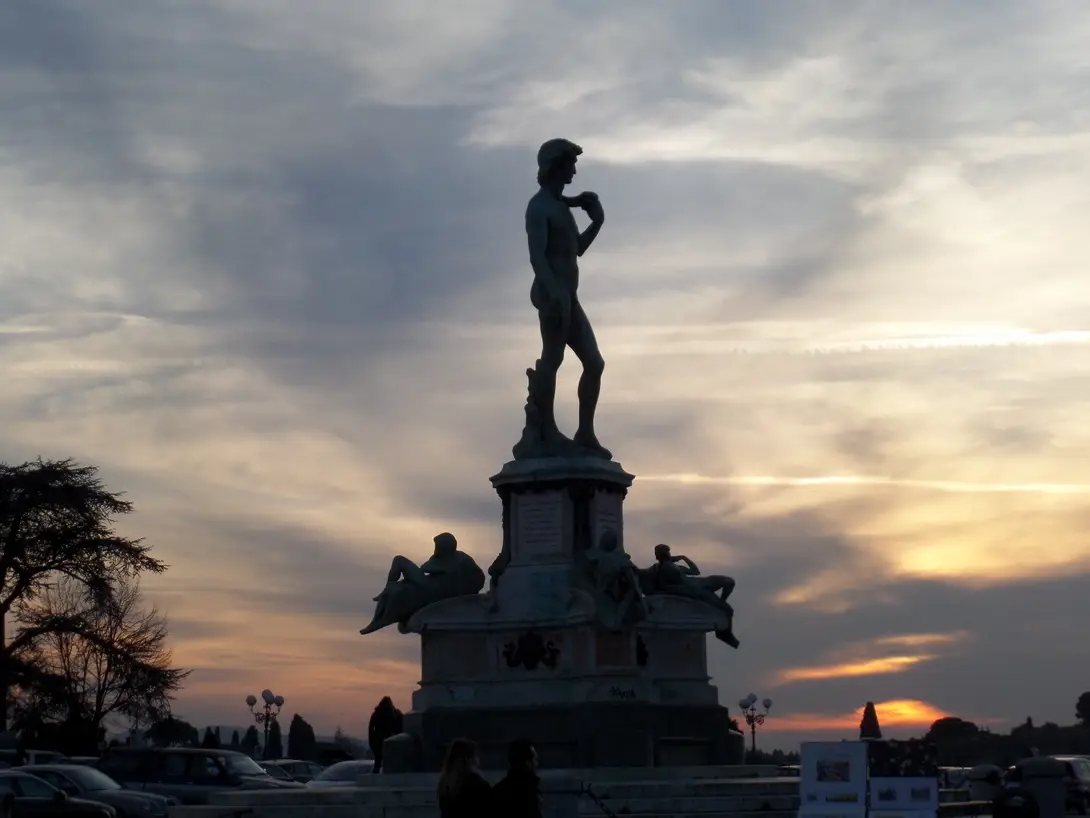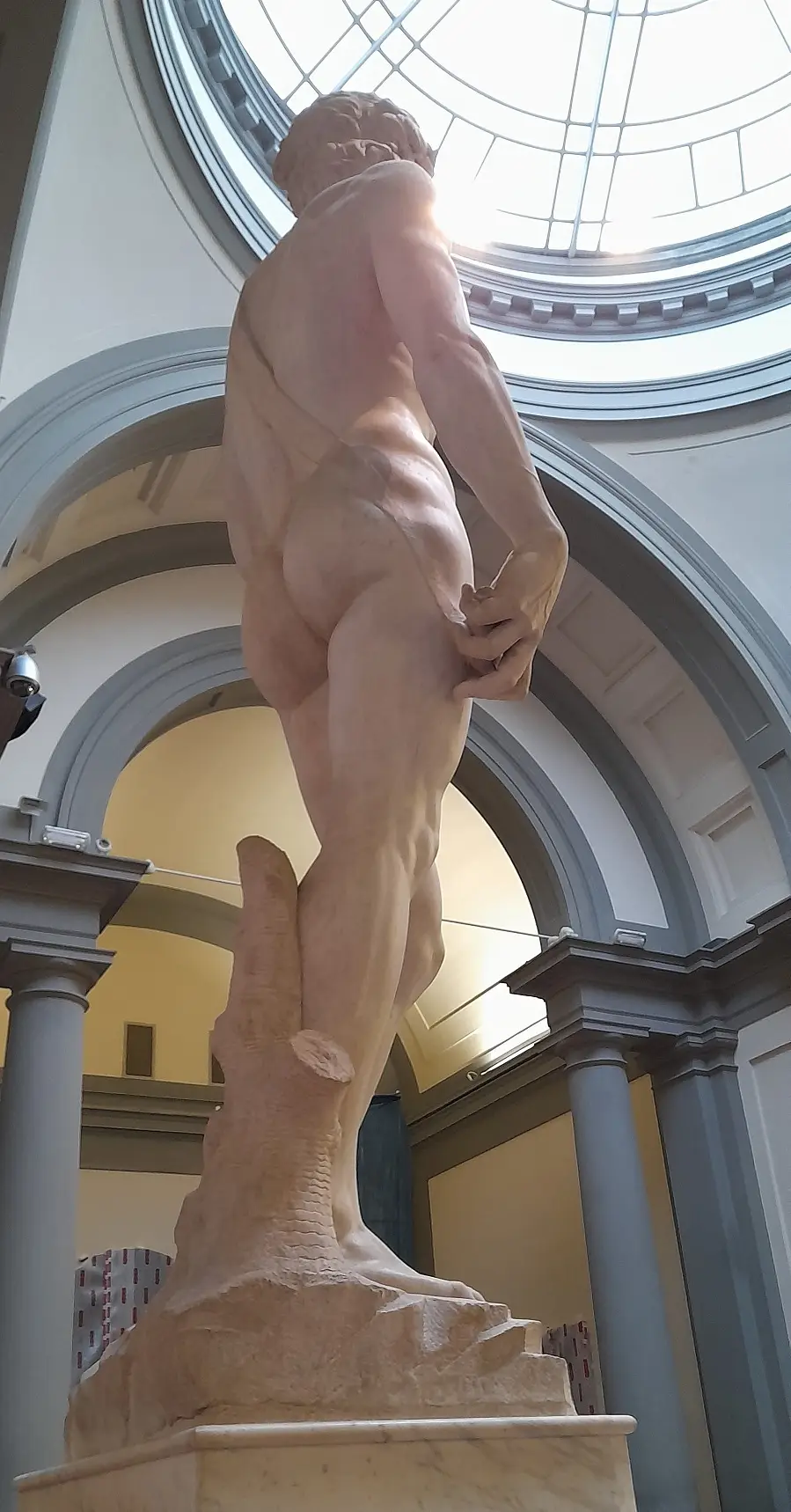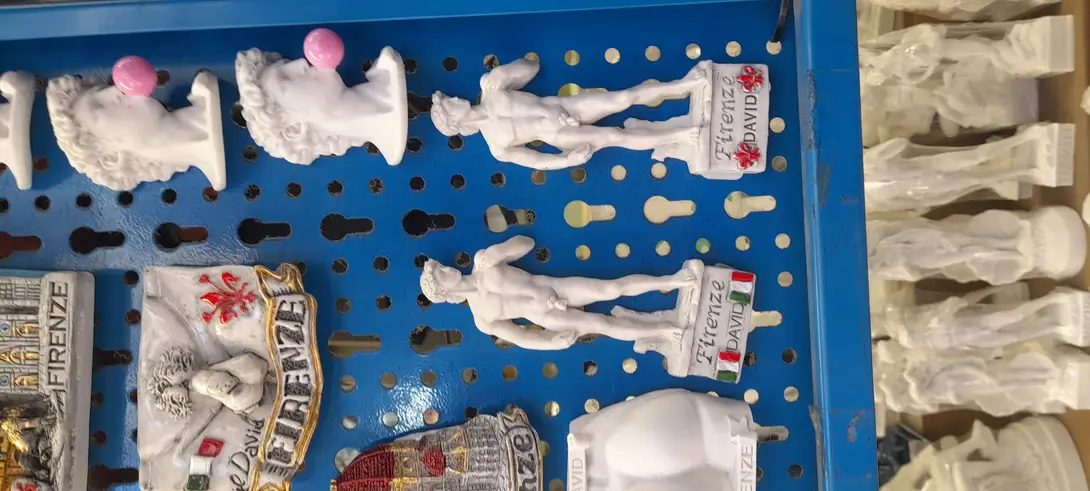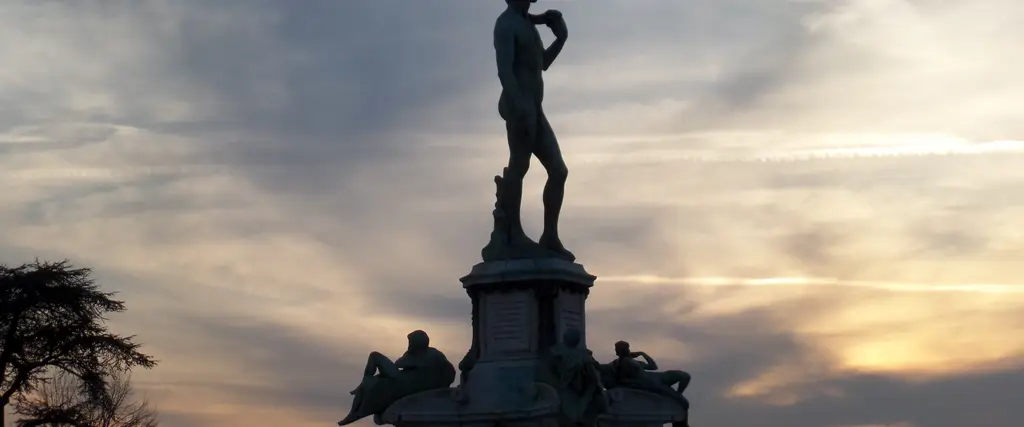
The David
Michelangelo's David, the best known and most admired man in Florence
The colossal statue, sculpted by a young Michelangelo Buonarroti in 1504, depicts David preparing to strike Goliath with a slingshot. It refers to a young and independent Florentine Republic opposing the tyrannical power of the seigniory
Michelangelo's statue is 517 cm high, a true giant, and is housed in the Accademia Gallery.
The subject has been reproduced by many artists - Donatello's David and Verrocchio's David, both in the Bargello Museum, are among the most famous - yet this David, so different and full of personality, can also be found elsewhere in the city. Did you think you saw it outside the museum? True, there are some copies that are admired perhaps more than the original because of their location.
The most popular is the copy placed on the front of Palazzo Vecchio in Piazza della Signoria, which is where the original was until 1872, when it was moved to the Accademia. Shall we remember the author? His name was Luigi Arrighetti, let us honour him.
Another copy that literally dominates the city is the one in Piazzale Michelangelo, a bronze statue of the famous young man at whose feet we find four bronze copies of the Allegories of the Medici Chapels in San Lorenzo.
And how many Davids are there in the city! Countless in the form of statuettes sold at every souvenir stall, while the mighty physique is reproduced on magnets, T-shirts, aprons and other objects with a slightly kitsch taste. but so be it, that is the price of celebrity.
Galleria dell'Accademia e Comune di Firenze
Les lieux
Étapes
Galleria dell'Accademia di Firenze - Academy gallery
The Academy Gallery (Galleria dell'Accademia) in Florence is known around the world as the ‘Michelangelo Museum’ (for the statues of David and the Prisoners), but it is actually much more than that.
It stands on the site where two convents originally stood, next to the Academy of Fine Arts, which still has its seat here. The first nucleus of the collection was formed in 1784 with a series of works of art, donated by the Lorraine Grand Duke Pietro Leopoldo; in 1873 Michelangelo's David, a true icon of western art, created by the artist between 1501and 1504, was moved here (from Piazza Signoria, replaced by a copy). Later, other works by Michelangelo arrived at the Accademia Gallery: the Four Prisoners (conceived for the tomb of Pope Julius II), the St. Matthew and the Palestrina Pietà, all unfinished works by the great artist, representing Michelangelo's famous ‘unfinished’.
In the Sala del Colosso is the original sketch of the Rape of the Sabine Women by Giambologna, together with numerous paintings of 15th and 16th century Florentine painting (Paolo Uccello, Botticelli, Perugino, Ghirlandaio, Filippino Lippi). Other important 16th-century paintings are exhibited along the Galleria dei Prigioni and in the Tribuna del David, adjacent to the Giposteca Bartolini, where numerous plaster casts by the famous 19th-century sculptor (and other contemporary artists) are collected.
In the Halls of the 13th and 14th centuries, numerous paintings can be admired, including works by important followers of Giotto (Tadeeo Gaddi, Bernardo Daddi, Orcagna) up to the International Gothic of the early 15th century. Don't miss the Museum of Ancient Musical Instruments (from the nearby Luigi Cherubini Music Conservatory, and even earlier from the Grand Ducal and Lorraine collections): about fifty pieces, including a viola and cello by Antonio Stradivari, a spinet and a forte-piano by Bartolomeo Cristofori, the inventor of the piano.
Piazza della Signoria
The square came into being along with the Palazzo Vecchio between the thirteenth and fourteenth century, establishing itself from the first as an area dedicated to the civic life of the city. Inside the Palace, seat of the Municipality of Florence you can also visit the Archaeological area (remains of the Roman Theatre) and climb the Tower (amazing panorama). In the course of the fourteenth century it took one more or less its present dimensions, as a result of the demolition of numerous private buildings and of two churches, and of the construction of the Loggia della Signoria on the west side and the Tribunale della Mercanzia (Commercial Court, nowadays Gucci Garden) on the north-east. Later developments were mostly connected with the sculptural decorations culminating, during the epoch of the Grand Duke, in the transformation of the Loggia della Signoria into a kind of open-air museum. The construction of the Uffizi (the most visited pianting gallery in Italy) connected with Palazzo Vecchio, in the mid sixteenth-century created a further prospect towards the river. The square was not immune from the nineteenth century renewal of the old city centre, within the course of which various Neo-Renaissance style buildings were introduced.
Piazza della Signoria has always represented the political centre of Florence becoming, over the years, the key place for many events that have strongly affected the history of the City and the entire world. In front of the XVI century Fountain of Neptune , one of the most beatiful fountains of Florence, there is a plaque on the ground marking the exact point where Fra Girolamo Savonarola and his fellow monks were burned on May 23rd 1498. This tragic episode is being commemorated every year with the traditional ceremony of the Fiorita.
In addition to the famous sculptures preserved inside the Loggia dei Lanzi (primarily Benvenuto Cellini's Perseus and Giambologna's Rape of the Sabine Women), among those in front of Palazzo Vecchio we highlight: Michelangelo's David (copy, original in the Galleria dell' Accademia), the Marzocco and Judith and Holofernes by Donatello (copies, originals respectively in the Bargello and inside Palazzo Vecchio). The square is dominated by the equestrian monument of Cosimo I de' Medici, Grand Duke of Tuscany, a work by Giambologna.
Piazzale Michelangiolo
Piazzale Michelangelo, the most famous panoramic terrace of the Florence...
The works for the construction of the square ended in 1875. The entire square should have become a monument to Michelangelo (in fact, the loggia was originally intended to bring together in a single museum all the statues of the great artist present in Florence). The design of this square, but also of the Viale dei Colli (the Michelangelo-Galileo-Machiavelli avenues which converge here), is due to the architect Giuseppe Poggi, protagonist of the urban transformations of Florence in the second half of the nineteenth century, at the time of Florence Capital of Italy.
Together with the nearby Forte di Belvedere, Piazzale Michelangelo is the panoramic point par excellence over the city: from here you can enjoy a breathtaking view of Florence and its monuments: the Duomo with the dome, Palazzo Vecchio with the Arnolfo tower, the basilica of Santa Croce, the Arno rivers and Ponte Vecchio... until you reach the hills of Fiesole. In the center of the square stands the Monument to Michelangelo, composed of bronze copies of his statues: the four Allegories (Day, Night, Twilight, Aurora) preserved in the old sacristy of the Medici Chapels and the imposing David whose original is today found in Accademy's Gallery.
A few steps from the square overlook the Iris and Rose gardens,the Michelangelo Park while, a little further up, there is one of the most evocative churches in Florence: San Miniato al Monte
It is always from up here that every year, on the evening of June 24th, the traditional Fireworks are exploded: the fireworks display to crown the celebrations of the city's patron saint.
